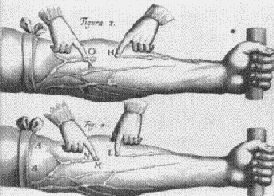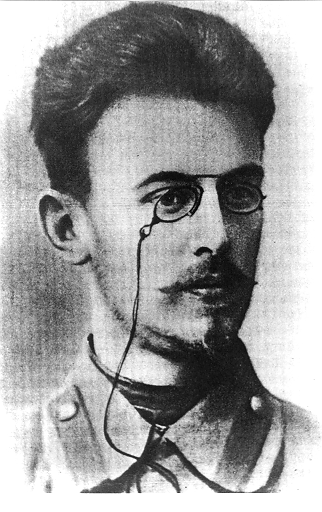
Blood Vessels
& Circulation
Heart --> Arteries--> Arterioles ---> Capillaries---> Venules ---> Veins ---> Heart
Vessel Wall Anatomy: 3 layers (except capillaries)
Arteries: Carry blood away from heart.
Elastic Arteries: have elastic connective tissue in t. media. Withstand large pressure changes. Elastic recoil is important in smooth blood flow.
Muscular Arteries: smaller arteries near organs. More smooth muscle in tunica media.
Arterioles: Smallest, thinnest arterial vessels. Feed capillary beds and major site of blood flow regulation in tissues.
Capillaries: Most numerous (1.2 billion). 1,000 square miles of potential surface area. But have only 4-5% of body's blood at rest.
Thin walled - only have tunica intima. Site of gas and nutrient exchange with tissues.
Venules: Smallest venous vessels. Smallest ones have no tunica media.
Veins: Three distinct tunics. Low pressure system. Blood flow to heart aided by skeletal muscle pump, respiratory pump, and one-way valves.
Contain 65% of body's blood at rest.
Varicose veins -- due to stretching of veins and weakening of valves.
Histology of Arteries, Veins and Capillaries (Virtual Hospital)
Historical Note: William Harvey's Demonstration of Valve Function

Physiology of Circulation
Blood Flow = amount of blood flowing thru a vessel or organ. Varies according to local factors and neural (ANS) regulation.
Blood Pressure = force per unit area exerted on vessel wall. Expressed in mmHg.
Resistance = opposition to flow; friction.
Major determinants of resistance are:
Resistance is proportional to 1/(radius)4 -- i.e., if radius is doubled or halved, resistance is decreased or increased 16 fold.
Viscosity and vessel length don't change much in the short term, so vessel diameter is the major factor determining resistance.
Flow = D Pressure/Resistance
Systemic Blood Pressure
Systolic arterial pressure: maximum pressure exerted by left ventricle.
Diastolic arterial pressure: minimum pressure in vessels.
Mean arterial pressure = Diastolic pressure + 1/3(SP - DP). Note, this is not a straight average since diastole lasts longer than systole.
Blood pressure drops primarily in the arterioles because of the numerous fine branches which increase the total cross-sectional area of vascular bed.
Blood Pressure = cardiac output X TPR
Anything that influences cardiac output or resistance will affect blood pressure.
Regulation of Blood Pressure
Nervous System Control:
Cortical: Cerebral cortex ("higher thought processes") can affect blood pressure
Chemical Control:
Variations in Blood Pressure
Measurement of blood pressure is usually by ausculatory methods. These methods rely on turbulence of blood flow causing detectable sounds.
Classical (using the Sounds of Korotkoff) method is use of sphygmomanometer. Inflated cuff blocks blood flow thru brachial artery. When external cuff pressure is high enough to just stop flow --> systolic arterial pressure. When cuff deflated, blood begins to flow thru artery, but flow is turbulent and can be detected with stethoscope. When blood flow just becomes quiet (laminar flow of blood) --> cuff pressure equals resting pressure in artery --> diastolic arterial pressure.
 Nicolai Sergevich
Korotkoff: The man behind the sounds!
Nicolai Sergevich
Korotkoff: The man behind the sounds!
Normal Range for Blood Pressure:
110-140 mmHg systolic
75-80 mmHg diastolic.
Hypotension: systolic pressure < 100 mmHg. Very relative. Some chronic conditions lead to hypotension.
Orthostatic hypotension: sudden change in posture -- blood wells up in lower extremities --> blood pressure drops --> blood flow to brain slows --> dizziness.
Age & medications (esp. beta blockers) affect orthostatic hypotension.
Hypertension: Persistent systolic pressure > 150 mmHg and/or diastolic > 90 at rest. Damaging to vessels, kidneys in particular.
Multiple causes.
The Puzzle of Hypertesion in African-Amercians: Scientific American Article
Blood Flow
Delivery of blood depends on metabolic "needs" of tissue.
How is "need" recognized by body?
Flow is proportional to Pressure/Resistance
Change in cross sectional area is the major determinant
Capillary Dynamics
Exchange of nutrients relies primary on diffusion.
Rate of diffusion will depend on permeability of capillaries and capillary pressures.
Permeability differences
Presence or absence of fenestrations.
Blood-brain barriers
Two Key Pressures:
Normal pressure difference results in net fluid movement into capillary.
For delivery of nutrients to tissues, there must be net fluid movement out of capillary, so net hydrostatic pressure must be greater than net osmotic pressure.
Excess interstitial fluid is recovered by lymphatic system.
Edema:.
Circulatory Shock: inadequate blood flow to meet metabolic needs of tissues.
From:
Blood Pressure & Capillary Hemodynamics
Pathophysiology of Circulatory Shock
Capillary Exchange Online Quiz
Pulmonary Circulation
Low pressure system
Blood flow must be slower and exert less pressure on fine capillaries.
Right Ventricle (low oxygen blood) --> Pulmonary Trunk --> Pulmonary arteries --> lobar arteries --> arterioles --> capillaries surrounding alveolar sacs --> pulmonary venules and veins (high oxygen blood) --> left atrium --> systemic circulation.
Transports blood from visceral (spleen, stomach and intestines) organs to liver--> blood then goes to heart.
Principal Systemic Arteries
Ascending Aorta
Brachiocephalic
Rt subclavian
Axillary
Brachial
Radial and Ulnar
Palmar arch and digitals
Rt common carotid
Internal carotid--corotid sinus at base (baro- & chemo-receptors)
External carotid
Facial & neck arteries
Left common carotid: like right common carotid
Left subclavian: like right subclavian
Thoracic musculature and organs--diaphragm, esophagus, intercostals, bronchials.
Abdominal aorta
Abdominal viscera--renals, mesenteric, gonadals.
Common iliacs
Internal iliac
External iliac
Deep femoral
Femoral
Popliteal
Tibial (anterior and posterior)
Peroneal
Plantar and digitals
Principal Veins
Superior Vena Cava
Left & Right Brachiocephalic
External and Internal jugulars
Cranial and facial vessels
Subclavians (left and right)
Axillary
Cephalic & basilic (superficial)
Median cubital (venipuncture site)
Brachial (deep)
Radial & Ulnar
Inferior Vena Cava: Thoracic, then abdominal portions--branch to form:
Left and Right Common Iliacs
Internal iliac
External iliac
Deep femoral
Femoral
Popliteal
Anterior and Posterior Tibial
Plantar veins
Great Saphenous (superficial-anterior)
Small Saphenous (superficial-posterior)
Saphenous Vein Commonly Used for Coronary Bypasses
Graphics From Wheeless' Textbook of Orthopaedics
Miscellaneous Links
Histology of Vascular System: Beautiful Site. May take a while to load, but worth the wait!
Blood Vessel Notes: general overview with illustrations.
More Blood Vessel Notes (based on Marieb's 4th ed. A & P text)
Health Central's Hypertension Site
History of Blood Pressure Measurement (in Portuguese) Historical Photos.